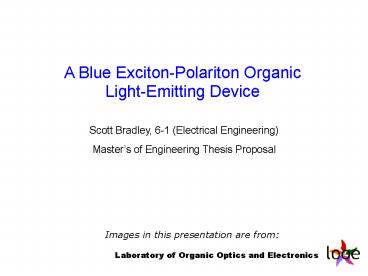A Blue ExcitonPolariton Organic LightEmitting Device - PowerPoint PPT Presentation
Title:
A Blue ExcitonPolariton Organic LightEmitting Device
Description:
Work on a blue exciton-polariton OLED would allow for more research in fabrication. ... Fabricate blue exciton-polariton OLED (spring 2005) ... – PowerPoint PPT presentation
Number of Views:58
Avg rating:3.0/5.0
Title: A Blue ExcitonPolariton Organic LightEmitting Device
1
A Blue Exciton-Polariton Organic Light-Emitting
Device
Scott Bradley, 6-1 (Electrical Engineering) Master
s of Engineering Thesis Proposal
Images in this presentation are from
Laboratory of Organic Optics and Electronics
2
Introduction
- Project Motivation
- Background
- Organic Light-Emitting Devices (OLEDs)
- J-Aggregates of Cyanine Dyes
- Resonant-Cavity OLED
- Device Fabrication
- Research and Resources
- Experimental Methods
- Timeline and Goals
- Summary
Laboratory of Organic Optics and Electronics
3
What is a Polariton?
- Quasi-particle consisting of a photon and an
exciton. - An exciton is an excited electron paired with a
holeexcited state of a molecule. - Exciton and photon pass energy back and forth.
4
Project Motivation
- Exciton-polariton OLEDs have potential in optics
applications. - Existing work has established theory and created
a red exciton-polariton OLED (J. Tischler). - Work on a blue exciton-polariton OLED would allow
for more research in fabrication.
Laboratory of Organic Optics and Electronics
5
Background Organic Light-Emitting Devices
Example ETL
Example HTL
Laboratory of Organic Optics and Electronics
6
Background J-Aggregates of Cyanine Dyes
We use polar organic dye molecules
-
which line up when deposited carefully
Called a J-Aggregate, named after Edwin Jelley of
Kodak, who described the phenomenon in Nature in
1936.
and strongly absorb only one type of light.
7
Background Resonant-Cavity OLED
- Create a cavity tuned to the J-Aggregate
absorption wavelength using silver mirrors.
- Thin layers of silver are semi-transparent, so
light is able get in and out of the cavity.
Microcavity
As long as the wavelength of light
Laboratory of Organic Optics and Electronics
8
Device Fabrication Dip-Coating
J-Aggregate-Polyelectrolyte Bi-Layers
Wavelength (nm)
Fabrication Demonstrated Using Bi-Layer
Deposition - Other J-Aggregates Likely Need
Langmuir-Blodgett
Absorption (Normalized)
Programmable Slide Stainer(1)
Wavenumber (cm-1)
- Picture of Stainer from www.leica-microsystems.com
- 400nm Bucher, Kuhn, Chem Phys Lett 6 (1970) 183
- 465nm Fukumoto,et al. Thin Solid Films 327329
(1998) 748 - 550nm Era, Adachi, Chem Phys Lett 178 (1991) 488
- 623nm Rousseau, et al., Langmuir 16 (2000) 8865
- 890nm Rotermund, et al. Chem Phys 220 (1997) 385
9
Research and Resources
- Plan to use dye with absorption around 465 nm.
- Process variation to improve fabrication
- pH variation of dye and polyelectrolyte
solutions. - Dye concentration.
- Number of layers.
- Substrate variation (currently glass/ITO slides).
- Different polyelectrolyte (currently PDAC).
- Might change mirror from metal to dielectric
Bragg reflector (DBR). - Planning to work with Prof. Vladimir Bulovic.
- LOOE has necessary fabrication equipment.
10
Experimental Methods
- Electroluminescence measurements on patterned
devices. LOOE - Photoluminescence measurements using 408 nm and
higher energy lasers for excitation (fix
excitation and scan through detection
wavelengths). LOOE - Photoluminescence-excitation measurements (fix
detection and scan through excitation). other
CMSE groups - Reflection and transmission measurements using
UV-Vis-NIR spectrometer. CMSE Shared Analytical
Lab
11
Goals and Timeline
- Goals
- Build a blue exciton-polariton OLED.
- Research fabrication process parameters.
- Timeline
- Currently doing related work in UROP position.
- Be trained on necessary equipment by end of
senior year. - Revisit M. Eng. thesis proposal and goals in
spring 2004. - 6.728 in Fall 2004, 6.730 in Spring 2005.
- Research process parameters to refine J-Aggregate
bi-layer deposition with 465 nm dye (fall 2004). - Fabricate blue exciton-polariton OLED (spring
2005).
12
Summary
- Blue exciton-polariton OLED fabrication and
research could provide more information for
further use of J-Aggregate-based devices. - Further understanding of deposition process could
help in creation of J-Aggregated-based devices in
NIR and IR.































